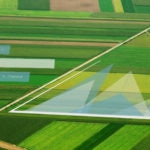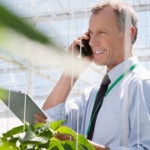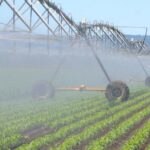The Internet of Things: the new green revolution
Agriculture stands at the threshold of a new revolution. The rising population, the competition for increasingly scarce resources and the phenomenon of climate change are just some of the challenges facing the sector as it seeks to feed all of humanity. We need to produce more with less, a challenge that the farm sector has already begun to answer, thanks to the Internet of Things, whose sensors have brought the benefits of big data to the farmsteads and croplands.

The U.N.Food and Agriculture Organization (FAO) warns that by 2050, there will be 9.3 billion mouths to feed on Earth, which means that 13.4 billion tons of food will have to be produced annually (or 62% more than right now). Added to this is are the fact that the planet has lost more than half of its arable land in less than half a century, and the undeniable effects of global warming on its ecosystems.
| Download complete book | |||
|
|||
The Internet of Things (IoT) is based on the existence of billions of devices that are connected directly to the Internet and that make it possible to store and circulate all the information the machines collect and produce, without human intervention. That collection of data is becoming an essential harvest for farm production; according to a report by Machina Research, in 2014 there were only 13 million agricultural devices connected to the Internet, but by 2024 there are expected to be 225 million.

Producing more and better
Smart farming facilitates decision making, the care of plants and animals and permits the automation of processes. It helps to increase productivity in a responsible fashion, establish the amounts and best times for irrigation and fertilization, improve the health of livestock, detect the presence of fungi and pests, and even control the classification and packaging of food products.
The benefits of precision agriculture and livestock farming are such that a recent report in Markets and Markets predicts that the market for intelligent agriculture will go from $5.180 billion in 2016 to $11.230 billion in 2020.
In 2014 there were only 13 million agricultural devices connected to the Internet, but by 2024 there are expected to be 225 million"
There are already many companies that have managed to increase their productivity thanks to the networks of sensors. Such is the case of NatureSweet, a Texas company dedicated to the production of cherry tomatoes, which has managed to improve its products and reduce costs by using a system developed by Prospera. This tool is capable of continually monitoring the state of crops (humidity levels, pollenation, fertilizers, pesticides…) and put all this information at the disposal of farmers in real time. For the moment, NatureSweet’s weekly production has increased by up to 4%.
The BBVA Foundation also seeks the development of precision agriculture. Professor Miguel Ángel Moreno’ project was selected by the entity in this edition of the Leonardo Scholarships. The work developed by Moreno and his team is based on the use of drones as a large scale scanner that allows to know the temperature of the plants and to know when and how much water they need.
However, the problem cannot be resolved just by increasing the amount of food. The management of scarce resources is another of the great challenges that this new green revolution will have to overcome. In Africa, where water is a limited resource, IBM has already begun to work on the ground. The tech giant has developed EZ Farm, a tool that informs farmers about when their crops need water, and how much.
Recover degraded ecosystems
The care and recovery of the environment is already benefitting from the developments that come from the Internet of Things. They have been used, for example, to restore a 240-hectar marsh that was formerly dedicated to cranberry production, MIT researcher Joseph Paradiso explains it in his book, The Next Step: Exponential Life, which can be downloaded for free on the website of BBVA’s OpenMind Project.
DoppelLab is the solution designed in Paradiso´s lab that is aimed at restoring a field degraded by agricultural exploitation to its natural state. In order to restore the ecosystem, hundreds of wireless sensors are installed to monitor parameters such as temperature, soil humidity, air and water quality, wind, ambient noise and even light quality. All these data are analyzed and used to guide the process of recovery of the site. In collaboration with a team of ecologists.

Connected animals
Not only the fields, but also the animals are becoming connected. There are already initiatives such as the EU project on precision livestock farming, (UE-PLF) that use sensors to continually monitor where animals are and how they are faring, analyze their breathing to detect possible infections and even determine the best time to milk the cows.
Some of the most interesting developments are taking place in the area of fish farming. This sector produces almost half the fish consumed in the world and is the fastest-growing segment of the food industry, according to data from Sensor Fish. This project – in which research centers from Europe, the United States and China participate – seeks to promote the use of networks of sensors to create a secure environment for breeding high-quality fish.
From the seed to the table
The absolute control offered by the Internet of Things goes from the beginning to the end of the food production process. The classification, transformation and even the packaging of the product are some of the possibilities offered by this technology. There are now software programs, such as the one developed by TempuTech that can monitor silos, conveyor belts and grain elevators. All the data is uploaded to the cloud, so that users know at all times the state of their facilities —very valuable information for avoiding plagues and for keeping products in optimum conditions—.
This is not the first time that technology has allied itself with the agricultural sector to solve humanity’s problems. History has been witness, from the Neolithic period through the agrarian transformation of the 18th Century, and to the current green revolution, of how science has improved the productive capacity of societies. The mechanization of work and the development of chemicals such as pesticides and fertilizers were all aimed at obtaining abundant harvests. The revolution that´s arriving now has another goal: the preservation of the environment and of natural resources. Precision agriculture and livestock farming are representative of the sustainable efficiency that the rural world requires.


